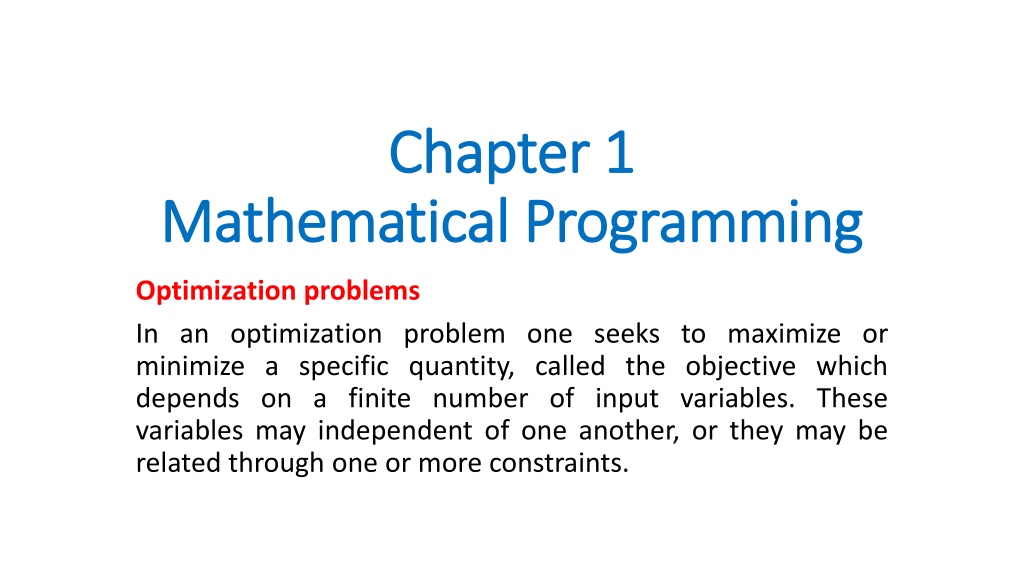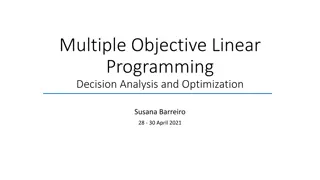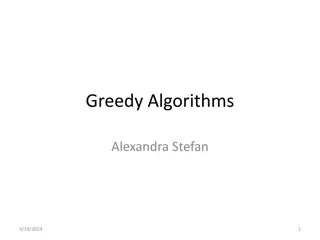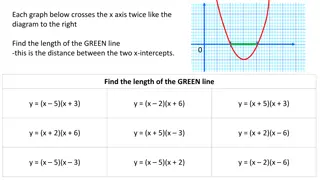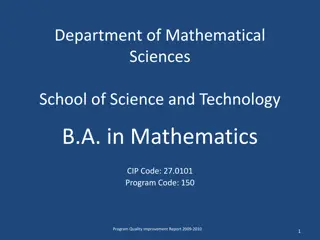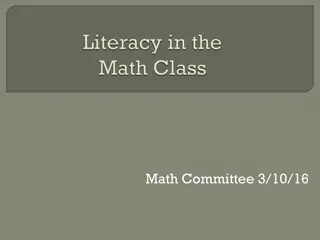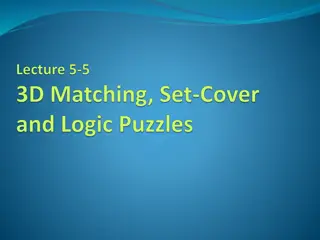Introduction to Mathematical Programming and Optimization Problems
In optimization problems, one aims to maximize or minimize an objective based on input variables subject to constraints. This involves mathematical programming where functions and relationships define the objective and constraints. Linear, integer, and quadratic programs represent different types of optimization problems with specific characteristics. Understanding these concepts is crucial in solving complex real-world problems efficiently.
Download Presentation

Please find below an Image/Link to download the presentation.
The content on the website is provided AS IS for your information and personal use only. It may not be sold, licensed, or shared on other websites without obtaining consent from the author. Download presentation by click this link. If you encounter any issues during the download, it is possible that the publisher has removed the file from their server.
E N D
Presentation Transcript
Chapter 1 Chapter 1 Mathematical Programming Mathematical Programming Optimization problems In an optimization problem one seeks to maximize or minimize a specific quantity, called the objective which depends on a finite number of input variables. These variables may independent of one another, or they may be related through one or more constraints.
Example 1.1: The problem 2+ ?2 2 Minimize ? = ?1 Subject to: ?1 ?2= 3 ?2 2 Is an optimization problem for the objective z. The input variables are ?1 and ?2. Which are constrained in two ways ?1must exceed ?2by 3 and also ?2must be greater than or equal to 2. It is desired to find values for the input variables which minimize the sum of their squares, subject to the limitations imposed by the constraints. A mathematical programs is an optimization problem in which the objective and constraints are given as mathematical functions and functional relationships (as they are in Example 1.1). Mathematical programs treated in this lectures have the form
Optimize: ? = ?(?1,?2,,??) ?1?1,?2, ,?? ?2?1,?2, ,?? ?1 ?2 ?? = Subject to: .. ???1,?2, ,?? Each of the m constraint relationship in 1.1 involves of the three signs ,= , . Unconstrained mathematical programs are covered by the formalism (1.1) if each function ??is chosen as zero and each constant ??is chosen as zero.
Linear programs Linear programs A mathematical program (1.1) is linear if ?(?1,?2, ,??) and each ???1,?2, ,?? ,? = 1,2, .,?) are linear in each of their arguments-that is, if ? ?1,?2, ,?? = ?1?1+ ?2?2+ .+???? ???1,?2, ,?? = ??1?1+ ??2?2+ .+????? Where ??and ???(? = 1,2, ..,? ;? = 1,2, ..,?) are known constants. Any other mathematical programs is nonlinear. Thus example 1.1 describes a nonlinear programs, in view of the form of z. 1.2 1.3
Integer programs Integer programs An integer program is a linear program with the additional restriction that the input variables be integers. It is not necessary that the coefficients in (1.2) and (1.3), and the constants in (1.1), also be integers, but this will very often be the case.
Quadratic programs Quadratic programs A quadratic program is a mathematical program in which each constraint is linear-that is, each constraint function has the form (1.3)- but the objective is of the form ? ?1,?2, ,?? = ?=1 ?=1 ???????+ ?=1 Where ???and ??are known constants. The program given in Example 1.1 is quadratic. Both constraints are linear, and the objective has the form (1.4), with ? = 2 (two variables), ?11= 1 ,?12= ?21= 0 ,?22= 1 ,??? ?1= ?2= 0. ? ? ? ???? (1.4)
Problem formulation Problem formulation Optimization problems most often are stated verbally. The solution procedure is to model the problem with a mathematical program and then solve the program by the techniques described in next chapters. The following approach is recommended for transforming a word problem into a mathematical program: Step 1: determine the quantity to be optimized and express it as a mathematical function. Doing so serves to define the input variables. Step 2: Identify all stipulated requirements, restrictions, and limitations, and express them mathematically. These requirements constitute the constraints. Step 3: Express any hidden conditions. Such conditions are not stipulated explicitly in the problem but are apparent from the physical situation being modeled. Generally they non-negativity or integer requirements on the input variables.
Solution Convention Solution Convention In any mathematical program. We seek a solution. If a number of equally optimal solutions exist, then any one will do. There is no preference between equally optimal solutions if there is no preference stipulated in the constraints.
Solved problems Solved problems 1.1: The Village Butcher Shop traditionally makes its meat loaf a combination of lean ground beef and ground pork. The ground beef contain 80 percent meat and 20 percent fat, and the coasts the shops 80c per pound. The ground pork contains 68 percent meat and 32 fat and costs 60c per pound. How much of each kind of meat should the shop use in each pound of meat loaf if it wants to minimize its costs and to keep the fat content of the meat loaf to no more than 25 percent?
1.1: The objective is to minimize the coast (in cents), z , of a pound of meat loaf, where z equal to 80 times the poundage of ground beef used plus 60 times the poundage of ground pork used. Defining ?1= Poundage of ground beef used in each pound of meat loaf ?2= Poundage of ground pork used in each pound of meat loaf We express the objective as Minimize: ? = ????+ ????
1.1: Each pound of meat loaf will contains ?.????pounds of fat contributed from the beef and ?.????pounds of fat contributed from the pork. The total fat content of a pound of meat loaf must be no greater than 0.25 Ib. therefore, ?.????+ ?.???? ?.?? The poundages of beef and pork used in each pound of loaf must sum to 1: hence ??+ ??= ?
1.1: Finally, the butcher shop may not use negative quantities of either meat, so the two hidden constraints are ?? 0 and ?? ?. Combining these conditions with (1), (2), and (3), we obtain Minimize: ? = ????+ ???? Subject to: ?.????+ ?.???? ?.?? ??+ ??= ? With: all variables nonnegative. System (4) is a linear program. As there are only two variables, a graphical solution may be given. (?)
1.2: Solve the linear program (4) of problem 1.1 graphically. See Fig 1.1. The feasible region the set of point (?1,?2) satisfy all the constraints, including the non-negativity conditions- is the heavy line segment in the figure. To determine? , the minimal value of z, we arbitrarily choose values of z and plot the graphs of associated objectives. By choosing ? = 70 and ? = 75, we obtain the objectives. 70 = 80?1+ 60?2 and 75 = 80?1+60?2 Respectively. It is seen that ? will be assumed at the upper endpoint of the feasible segment, which is the intersection of the two lines 0.20?1+ 0.32?2= 0.25 ?1+ ?2= 1 (?) (2)
?1+ ?2= 1 0.20?1+ 0.32?2= 0.25
1.2: Simultaneous solution of these equations gives ?1+ 1.6?2= 1.25 ?1 ?2= 1 0.6?2= 0.25 ?2=0.25 (1) 5 2 1 5 12 7 12 0.60= 5 12= ? ?? ?1= 1 ? ?? ? = ?? + ?? = ??.???
1.3: A furniture maker has 6 units of wood and 28 h of free time, in which he will make decorative screens. Two models have sold well in past, so he will restrict himself to those two. He estimates that model requires 2 units of wood and 7 h of time, while 11 requires 1 unit of wood and 8h of time. The prices of the models are $120 and $80, respectively, how many screens of each model should the furniture maker assemble if he wishes to maximize his sales revenue?
1.3: The objective is to maximize revenue (in dollars), which we denote as: Z equals 120 times the number of model I screens produced plus 80 times the number of model II screens produced. Letting ?1= Number of model I screens produced ?2= Number of model II screens produced We express the objective as ???????? ? = 120?1+ 80?2 (1)
1.3: The furniture maker is subject to a wood constraint. As each model I requires 2 units of wood, 2?1 units must be allocated to them likewise. 1?1Units of wood must be allocated to the model II screens. Hence the wood constraint is 2?1+ 1?2 6 The furniture maker also has a time constraint. The model I screens will consume 2?1 hours and the model II screens will consume 8?2 hours, and so 7?1+ 8?2 28 It is obvious that negative quantities screen cannot be produced, so two hidden constraints are ?1 0 and?2 0. Furthermore, since there is no revenue derived from partially completed screens, another hidden condition is that ?1 and ?2 be integers. Combining these hidden conditions with (1), (2) and (3), we obtain the mathematical program. (2) (3)
1.3: ???????? ? = 120?1+ 80?2 Subject to: 2?1+ 1?2 6 7?1+ 8?2 28 (4) With: all variables nonnegative. System (4) is a linear program. As there are only two variables, a graphical solution may be given.
1.4:Give a graphical solution of the integer program (4) of problem 1.3. See Fig 1.2. The feasible region is the set of integer points (?1,?2) within the shaded area. The dashed lines are the graphs of the objective function when z is arbitrarily given the values 240,330, and 380. It is seen that the line though the point (3, 0) will furnish the desired maximum thus the furniture maker should assemble three model I screens and no model II screens. For maximum revenue of ? = ??? ? + ?? ? = $??? Observe that this optimal answer is not achieved by first solving the associated linear program (the same problem without the integer constraints) and then moving the closest feasible integer point. In fact, the feasible region for the associated linear program is the shaded area fig 1.2 so the optimal solution occurs at the circled corner point. But at the closest feasible integer point, (2.1), the objective function has the value ? = 120 2 + 80 1 = $320 or $40 less than the true optimum.
2?1+ ?2= 6 7?1+ 8?2= 28
1.5: Universal Mines Inc. operates three mines in West Virginia. The ore from each mine is separated into two grades before it is shipped; the daily production capacities of mines, as well as their daily operating costs, are as follows: High-Grade Ore, tons/day Low-Grade Ore, tons/day Operating cost $1000/day Mine I 4 4 20 Mine II 6 4 22 Mine III 1 6 18 Universal has committed itself to deliver 54 tons of high-grade ore and 65 tons of low-grade ore by the end of the week. It also has labor contracts that guarantee employees in each mine a full day s pay for each day or fraction of a day the mine is open. Determine the number of days each mine should be operated during the upcoming week if Universal Mines is to fulfill its commitment at minimum total coast.
1.5: Let ?1,?2 and ?3, respectively, denote the numbers of days that mines I, II and III will operated during the upcoming week. Then the objective (measured in units of $1000) is ??????? ? = 20?1+ 22?2+ 18?3 The high-grade ore requirement is 4?1+ 6?2+ ?3 54 The low-grade ore requirement is 4?1+ 4?2+ 6?3 65
1.5: As no mine may operate a negative number of days, three hidden constraints are ?1 0 , ?2 0 and ?3 0. Moreover, as no mine may operate more than 7 days in week. Three other hidden constraints are ?1 7 , ?2 7 and ?3 7. Finally, in view of the labor contracts, Universal Mines has nothing to gain in operating a mine for part of a day, consequently, ?1,?2 and ?3 are required to be integral combining the hidden conditions with (1), (2) and (3), we obtain the mathematical program
1.5: ??????? ? = 20?1+ 22?2+ 18?3 Subject to 4?1+ 6?2+ ?3 54 4?1+ 4?2+ 6?3 65 ?1 7 ?2 7 ?3 7
